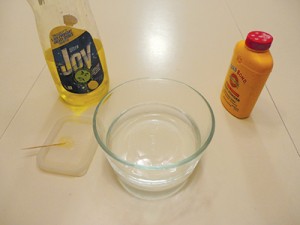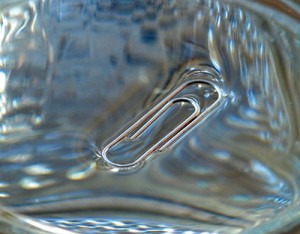Simple Science Experiments: Baby Powder and Surface Tension
 Let’s kick off the New Year with another simple science experiment. Ever see a bug skitter across the surface of a pond? Ever wonder why raindrops are the shape they are? This month’s simple science project will delve into the world of water’s surface tension with a couple of experiments.
Let’s kick off the New Year with another simple science experiment. Ever see a bug skitter across the surface of a pond? Ever wonder why raindrops are the shape they are? This month’s simple science project will delve into the world of water’s surface tension with a couple of experiments.
Surface tension is a barrier formed on the surface of water caused by something called “cohesion.” Liquids all have this force ─ a force that holds a material together. Some are stronger than others; for example, liquid mercury is a highly cohesive liquid. Cohesion is what causes water to have that spherical shape when it falls from the sky, or sits on a counter in a droplet. Go ahead and put a tiny drop of water on your kitchen table and look at it from the side: you will notice a “bubble” shape. This is the water pulling itself together. These following two trials will demonstrate this concept, as well as show you how to break surface tension.
Experiment 1
 Materials:
Materials:
- Cereal bowl
- Water
- Baby powder
- Liquid soap
- Toothpick
Procedure:
- Fill a bowl with water.
- Shake the baby powder onto the surface of the water. Do you notice how it stays afloat? That is the surface tension holding the layer up.
- Take a toothpick and put the end into soap so that it coats the tip.
- Then, gently touch the surface of the water with the toothpick.
Did you see how the powder shoots back in all directions? What must the soap be doing to the surface tension? Soap is something that actually breaks down the cohesive power of water, making it have less surface tension. If you mix some soap with water and make a water droplet on your counter again, what do you think the shape would look like? Give it a try!
Experiment 2
Materials:
- Bowl
- Water
- Liquid soap
- Toothpick
- Single staple from a stapler that is not folded in yet (open the stapler and pop out one staple, it should be in the right form)
Procedure:
- Fill the bowl with water close to the top.
- Very gently place the staple on the surface of the water so that it floats. This CAN be done, but you have to be very patient and careful!
- Observe the surface of the water around the floating staple. It should look like the staple is pushing into the water, much like your head as it pushes into a pillow.
- Take the clean toothpick and touch the surface of the water. What happens?
- Now, take the toothpick and put it in soap again. Did you guess what happens to the surface of the water?
The soap once again breaks the surface tension of the water, causing the staple to no longer be supported.
 Explanation:
Explanation:
Now, you’re probably thinking that this is a cool thing that water does, but why is surface tension important? Insects wouldn’t be able to skip across the water without it, and even your water skis keep you above the water due to surface tension. By understanding how soap breaks down surface tension in water, you have the ability to clean off your dirty dishes after you eat. Thanks surface tension!
Steve Davala is a middle school science teacher who likes to write. He’s has two kids and subjects them to such science activities as guinea pigs. Follow him on Twitter or email him at steve.davala@gmail.com.







